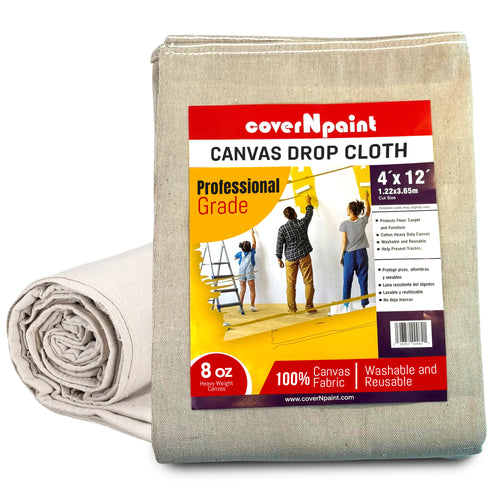Art is a dynamic and ever-evolving field, with artists constantly expanding the limits of creativity. While oil on canvas has traditionally been the gold standard for masterpieces, recent years have seen artists experimenting with a variety of materials to broaden the scope of artistic expression. One such unconventional material gaining traction among contemporary artists is the canvas drop cloth, a common household item used in construction and renovation.
The Evolution of Artistic Materials
Art history is replete with examples of artists who have experimented with unconventional materials. From the cave paintings of prehistoric times to the use of gold leaf in Byzantine icons, the evolution of artistic materials is a testament to human ingenuity. The modern era, with its technological advancements and changing societal norms, has seen a significant shift in the materials artists choose to work with.

Why Choose Non-Traditional Materials?
There are several reasons why an artist might choose to work with unconventional materials.
Affordability
Traditional canvases and art supplies can be expensive. For emerging artists or those working on a tight budget, alternative materials offer a cost-effective solution.
Accessibility
Unconventional materials are often readily available. This accessibility allows artists to experiment without the constraints of specialized art supplies.
Texture and Surface
The unique texture and surface of non-traditional materials can add depth and dimension to a piece. These materials can provide a distinctive look that is difficult to achieve with traditional canvases.
Eco-Friendliness
Using repurposed or recycled materials aligns with the growing trend of sustainability in art. This approach not only reduces waste but also brings attention to environmental issues through the artwork.
Benefits of Painting on Non-Traditional Surfaces
Unique Aesthetic
Unconventional materials often have a unique texture and appearance that can enhance the visual appeal of a painting. The natural folds, creases, and fibers of certain materials can add an organic quality to the artwork, making it stand out.
Versatility
These materials are incredibly versatile. They can be cut, stretched, and manipulated to fit the artist's vision. This flexibility allows for a wide range of artistic expressions, from detailed realism to abstract forms.
Durability
Certain non-traditional materials are more durable than traditional canvases. They can withstand rough handling, making them ideal for large-scale works or pieces intended for high-traffic areas.
Creative Freedom
Working with unconventional materials can free artists from the constraints of tradition. This liberation encourages experimentation and innovation, leading to the creation of truly original works of art.
Challenges of Using Non-Traditional Materials
While there are numerous benefits to using unconventional materials, artists must also be aware of the challenges.
Preparation
Non-traditional materials often require additional preparation before they can be used as a painting surface. This preparation can include cleaning, priming, and sometimes even structural reinforcement.
Absorption
These materials may absorb paint differently than traditional canvases. Artists need to experiment with different types of paint and application techniques to achieve the desired effect.
Longevity
The longevity of artwork created on non-traditional materials can be a concern. Artists need to consider how the material will age over time and whether it will maintain its integrity.
Presentation
Presenting artwork on unconventional materials can be challenging. Finding suitable framing or mounting options can require creativity and resourcefulness.
Practical Tips for Painting on Non-Traditional Surfaces
For artists intrigued by the idea of using unconventional materials, here are some practical tips to get started.
Choose the Right Material
Select a material that suits your artistic style and the type of paint you plan to use. Consider the texture, weight, and durability of the material.
Prepare the Surface
Proper preparation is crucial. Clean the material thoroughly to remove any dust or debris. Depending on the material, you may need to prime it with a suitable primer to ensure the paint adheres well.
Experiment with Techniques
Different materials will respond differently to various painting techniques. Experiment with different brushes, application methods, and types of paint to find what works best.
Protect Your Work
Once your painting is complete, consider applying a protective sealant to enhance its durability. This step is especially important if the artwork will be displayed in a high-traffic area or exposed to the elements.
Get Creative with Presentation
Think outside the box when it comes to presenting your artwork. Explore different framing and mounting options that complement the unique qualities of the material.
The Future of Art with Unconventional Materials
As the art world continues to evolve, the use of unconventional materials is likely to become more prevalent. Several factors contribute to this trend.
Technological Advancements
Advancements in technology are expanding the range of materials available to artists. 3D printing, for example, allows for the creation of complex structures that were previously impossible to achieve.
Environmental Awareness
The growing awareness of environmental issues is driving artists to seek sustainable alternatives to traditional materials. This shift not only reduces the environmental impact of art but also raises awareness about important issues through the artwork itself.
Cultural Shifts
As society becomes more inclusive and diverse, the art world is embracing a wider range of voices and perspectives. This inclusivity is fostering a spirit of experimentation and innovation, encouraging artists to explore new materials and techniques.
Cross-Disciplinary Collaboration
Collaboration between artists and professionals from other fields, such as science, engineering, and technology, is leading to exciting new possibilities. These cross-disciplinary collaborations are pushing the boundaries of what is possible in art, resulting in groundbreaking works that challenge traditional notions of creativity.
Unconventional Art Materials
The use of unconventional materials in art is not merely a trend but a testament to the boundless creativity and ingenuity of artists. While traditional canvases will always have their place, exploring alternative materials opens up a world of possibilities. Whether driven by necessity, curiosity, or a desire to challenge the status quo, artists who embrace these materials are pushing the boundaries of artistic expression.













